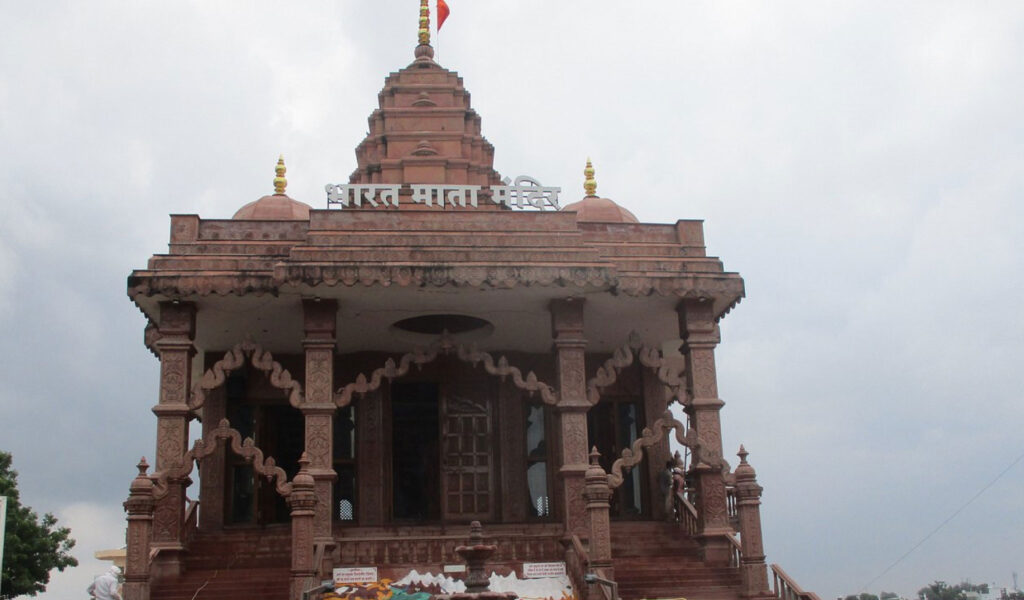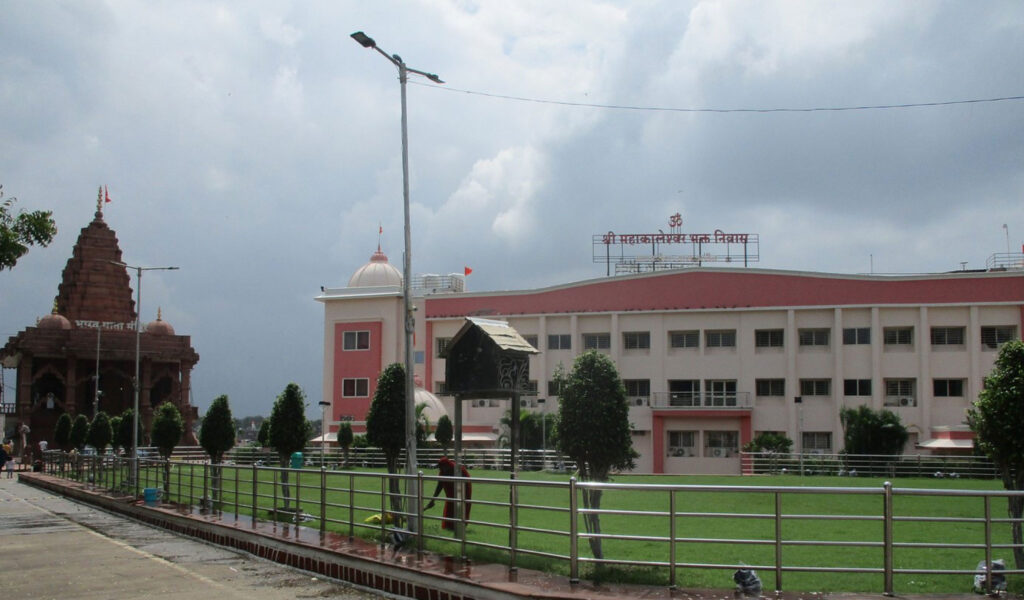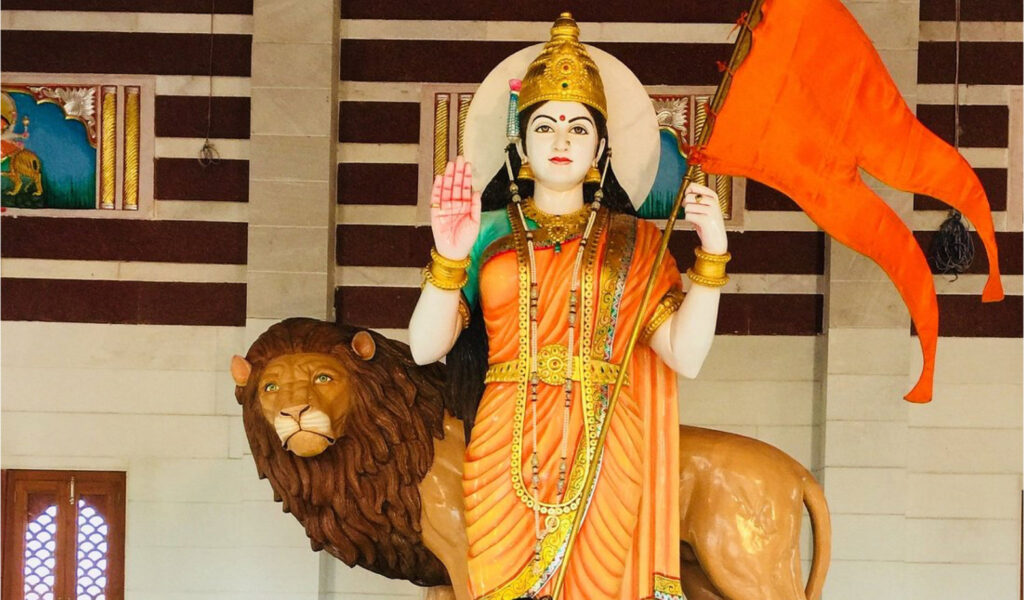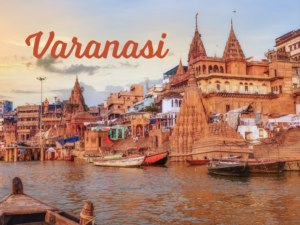Bharat Mata Mandir – The Temple of the Nation’s Soul

Unlike most temples in Varanasi that are dedicated to deities, the Bharat Mata Mandir stands out as a shrine devoted to the idea of India itself. Here, Mother India is worshipped not through idols, but through a massive carved relief map made of marble — a symbol of unity, geography, and pride. Among all famous places in Varanasi, this temple uniquely celebrates the spirit of the nation rather than a single god.
Whether you’re a traveller, student, or pilgrim, Bharat Mata Mandir offers a fascinating mix of patriotism, history, and architectural beauty — a must-visit stop among your Varanasi visit places.
Where Is Bharat Mata Mandir? (With GPS Coordinates)

📍 Coordinates: 25.3295° N, 83.0021° E
The Bharat Mata Mandir is located within the Mahatma Gandhi Kashi Vidyapeeth campus in central Varanasi, about 2 km from Varanasi Junction Railway Station and 4 km from Godowlia Chowk.
Its central location makes it easily accessible from any part of the city — taxis, autos, and even local e-rickshaws can take you there. If you’re exploring with a tour guide in Varanasi, the temple is often included as part of a “modern Varanasi” circuit alongside the university and nearby heritage sites.
Mythological & Historical Significance

The Bharat Mata Mandir holds a unique place in India’s modern history. It was inaugurated by Mahatma Gandhi in 1936, long before India achieved independence. Unlike traditional temples, it does not feature any deity, idol, or religious ritual — instead, it is dedicated to Bharat Mata (“Mother India”) as a symbol of the motherland itself.
The temple was envisioned by Babu Shiv Prasad Gupta, a noted freedom fighter and philanthropist from Varanasi. His idea was to inspire national unity across religions, castes, and regions. Inside the temple lies a massive 3-D relief map of undivided India, carved out of marble to show the mountains, plains, and rivers — from the Himalayas to the Indian Ocean.
This temple is both spiritual and patriotic — a rare landmark among places of visit in Varanasi that blends devotion with geography.
Architecture

The temple’s structure is simple yet monumental, designed to reflect dignity rather than opulence. Built in white and red stone, it rises over two floors with broad corridors and minimal ornamentation.
At its heart lies the marble relief map of India (10.7 m × 9.7 m), perfectly scaled to represent the subcontinent’s physical features. Rivers like Ganga and Yamuna, mountain ranges, plateaus, and coastlines are all depicted in stunning detail.
The design was supervised by freedom-era engineers, ensuring scientific accuracy — a rare example of cartography meeting art. The temple’s open, non-sectarian layout symbolizes unity and equality, making it one of the most intellectually and emotionally stirring famous places in Varanasi.
What You’ll See & Do at Bharat Mata Mandir
Start your visit by walking around the central marble relief map — the temple’s main sanctum. You’ll notice elevated walkways that allow you to view the map from above, observing India’s geographical beauty.
Guides or caretakers often explain the structure’s significance, pointing out major regions, mountain peaks, and river systems. For students and families, this is an educational stop as well as a patriotic one.
In the courtyard, you’ll find inscriptions dedicated to freedom fighters, along with portraits of leaders who contributed to India’s independence.
Many travellers pair this visit with Gandhi’s Kashi Vidyapeeth, just next door, for deeper context. Hiring a tour guide in Varanasi helps connect this temple to the broader narrative of India’s cultural and national rebirth in the early 20th century.
How to Reach Bharat Mata Mandir
•By Air: The nearest airport is Lal Bahadur Shastri International Airport, Varanasi (≈ 25 km). Taxis and autos are readily available.
•By Train: The temple is only 2 km from Varanasi Junction (Cantt) station and 4 km from Kashi Railway Station.
•By Road: It’s located on Bharat Mata Mandir Road, easily accessible by e-rickshaw, taxi, or city bus.
Because the area is part of an educational campus, parking is available nearby. If you’re touring major Varanasi visit places, this temple fits well into a half-day itinerary — especially when guided by a local expert or tour guide in Varanasi.
Combine your visit with nearby landmarks to create a balanced itinerary of modern and ancient Kashi:
•Mahatma Gandhi Kashi Vidyapeeth: University campus established in 1921, associated with the freedom movement.
•Kashi Vishwanath Temple: The most revered Shiva Jyotirlinga, about 5 km away.
•Dashashwamedh Ghat: For the iconic Ganga Aarti.
•Durga Temple & Tulsi Manas Mandir: In the southern temple circuit.
Together, these highlight the diversity of famous places in Varanasi — from spiritual to nationalistic, from ancient to modern.
Best Time to Visit & Travel Tips
Best Time: October to March, when the weather is mild and walking around the open campus is comfortable.
Tips:
•The temple is open from 9:30 AM – 8:00 PM daily.
•Entry is free, and photography is allowed.
•Visit early morning for quiet surroundings and good light for photography.
•Wear comfortable footwear and carry water, as you may walk around the map and adjoining areas.
•The temple does not involve religious rituals — it’s ideal for students, families, and anyone interested in India’s unity and geography.
•Combine with nearby temples for a full day of Varanasi visit places exploration.
Suggested Itinerary
Day 1: Arrive in Varanasi → Evening Ganga Aarti at Dashashwamedh Ghat.
Day 2: Morning visit to Bharat Mata Mandir → Explore Kashi Vidyapeeth campus → Lunch → Visit Durga Kund and Tulsi Manas Mandir → Sunset at Assi Ghat.
Day 3: Explore Sarnath and Kashi Vishwanath Corridor → Shop for Banarasi silk and souvenirs.
This combination of patriotic, spiritual, and historical experiences gives a complete sense of what makes Kashi timeless.
FAQ – Bharat Mata Mandir, Varanasi
Q1. What is the Bharat Mata Mandir, Varanasi famous for?
A: The temple is unique in that it is dedicated not to a specific deity but to “Mother India”. It features a large marble relief map of undivided India instead of idols.
Q2. Where is the temple located?
A: It is situated on the campus of Mahatma Gandhi Kashi Vidyapith in Varanasi, Uttar Pradesh.
Q3. When was the temple inaugurated and by whom?
A: The temple was inaugurated in 1936 by Mahatma Gandhi and built by freedom-fighter Babu Shiv Prasad Gupta.
Q4. What are the timings and is there an entry fee?
A: Entry is free of charge. Typical opening hours are approximately 9:30 AM to 8:00 PM, though some sources list morning from ~8:00 AM.
Q5. Are tourists / non-locals allowed to visit?
A: Yes. The temple is open to all regardless of nationality or religion.
Q6. Can you take photographs inside?
A: Yes, photography is generally allowed, especially of the marble relief map. However, as with any sacred site, some areas may have restrictions—visitors mention checking on site.
Q7. What is the best time of year to visit?
A: The cooler months, October to March, are recommended for comfort. Summer can be very hot in Varanasi.
Q8. Are there facilities for differently-abled visitors?
A: According to one source the temple is “fully accessible to physically disabled”.
Q9. Does the temple hold religious rituals or festivals like a traditional temple?
A: While national holidays like Independence Day and Republic Day are celebrated, it doesn’t house traditional deity-based rituals. The focus is on national unity and cultural heritage.
Q10. How much time should I allocate for visiting?
A: Visitors typically spend 30-60 minutes, depending on interest in the marble map and reading inscriptions.
Conclusion
The Bharat Mata Mandir is not merely a temple — it’s a living map of India’s heart and heritage. Standing before its marble relief, you don’t just see the land; you feel the unity of its rivers, mountains, and people.
In a city devoted to gods, this temple reminds us that the nation itself can be sacred. Among the famous places in Varanasi, it offers a rare and uplifting perspective — where devotion meets patriotism. Whether you come as a pilgrim, student, or traveller, this stop will leave you inspired by the spirit of Mother India herself.





